
Katie Hawkinson is an abstract artist. Her paintings, drawings, prints, and constructions are based on nature. She teaches at Stanford and the College of Environmental Design, U.C. Berkeley – and she makes art. All the time.
Her art is not on its face quirky, but as the arbiter of what is and is not quirky, I find the fact that a person makes a living painting what she wants to paint – that’s quirky


Hawkinson grew up on the eastern shore of the Chesapeake Bay in Easton, Maryland. Frederick Douglas was for all intents and purposes born in Easton.

Hawkinson captions this photo “My first studio, Playtor’s Cove.”

In the interest of complete honesty, she gave me this photo of what was probably her true first studio.

She boarded at the Westtown School for high school, class of 1984. This photo is from early in her Westtown years.

The Westtown School opened in May, 1799. That’s a long time ago. My school had been open for 14 years at the time – no brag, just fact.
Twenty boys and twenty girls entered the school from Quaker families living primarily in Pennsylvania and New Jersey, Today there are about 700 students. It is one of several Friends/Quaker school in the Philadelphia area. My best friend Peter Korn went to another one, Germantown Friends. We envied their progressive politics and coeducation.


The school owns a large lake. My school shop teacher Drex cut blocks of ice on that lake in his youth. So did Katie’s grandfather.
Growing up, my family day-camped and sometimes overnight-camped at the lake. Swimming, cook-outs, fishing, canoes, walking, card games, reading – summer in Pennsylvania.
Three thousand miles from where I grew up, I don’t often run into people with a shared past. With Katie – there it is – Westtown!

There is a school farm. The peaches are to die for. Before driving to Maine for vacation in August, we’d buy a couple bushels to give to our friends the Gay family in South Bristol. They were really good peaches.
In the fall, the packing shed was filled with apples and cider. What a smell! The memory of that smell came to me as I read Cider House Rules.
But wait – not done with connections.

Cres Fraley was my Best Friend In The World growing up. His sisters were my sisters. Hilary is the youngest. Talk about a magic journey –
Hilary went to Westtown. Katie was friends with her, still is. Katie has been to the Fraley farm in Chester Springs. Of the green rolling hills of West Virginia, Emmylou Harris sings that they “Are the nearest thing to heaven that I know.” Which is what I would say about the Fraley farm. Fraley sister Karen and her husband Jake live there now.

Hilary owns Hay Creek Bread in Birdsboro, Pennsylvania. Birdsboro is in Berks County, Pennsylvania, located along the Schuylkill River, 8 miles southeast of Reading. In the past, Birdsboro was known for its large foundries and machine shops, none of which operate today.
From Westtown, Katie went to the Rhode Island School of Design.

She got her BFA in painting
Painting had informed her time at Westtown.

The Giant by N. C. Wyeth has hung in the Dining Room of Westtown School since 1923, a memorial commissioned by members of the Class of 1910 to honor their deceased classmate, William Clothier Engle. The painting pays tribute to an artistic young man lost in the prime of his life.
The next Wyeth generation, Andrew, worked out of Chadds Ford, Pennsylvania, which is 8 miles from Westtown. His name and fame were huge.

P.S. It’s all about me: N.C. Wyeth and my maternal grandfather were close friends. The Wyeths came to my grandparents house in Bryn Mawr for Christmas. Young Andrew stood by the Christmas tree with a sponge on a pole to douse any candles on the tree that got out of hand. My mother’s family visited the Wyeths at a mutual friend’s house in South Bristol, Maine.
And – I have written about N.C. Wyeth elsewhere in this blog.

Here endeth it’s all about me.
Hawkinson moved to San Francisco in 1985, almost a year after graduating from RISD with no obvious job skills or connections. Katie: “I always knew that I wanted to go to graduate school for Painting eventually and I also knew that I needed to figure out how to paint outside of school with no assignments and no feedback.”
Most of her friends from art school were professional artists: architects, landscape architects, graphic designers, jewelers, and the like. Their art was their job. Katie: “I needed a day job to survive and I needed to paint and imagine in order to exist.” Her day job became catering both as a server and a cook.
Crack cocaine had ravaged American cities in the 1980s. By 1990, the prison population had doubled due to the arrest of drug dealers and their customers. And the street price of crack in San Francisco doubled. Which led to a surge in crime by addicts bankrolling their habits. Katie was mugged twice.
Hawkinson applied for grad school in 1989. Katie: “None of my friends were very encouraging about my going to graduate school for painting. I had met Joe around 1988 in passing in larger groups of overlapping circles of friends. We had never spoken. In the Fall of 1989 when I was working on my applications and writing a statement of purpose we found ourselves at a baby shower. We spoke for the first time and I told him somewhat self-deprecatingly that I was applying to Painting programs. He responded enthusiastically that of course I should apply and go to Grad school and elaborated as to why. It was the first positive encouragement outside of family that I’d had and it meant a lot to me. “
She went to the University of Washington in Seattle for graduate school. After graduating, in the fall of 1992 she drove down to the Bay Area for a friend’s wedding. Joe was at the wedding. Katie: “I hadn’t seen or talked to him in all that time. I did remember his encouragement though and reintroduced myself to him and thanked him. We ended up talking the entire reception evening and exchanged contact information. A few weeks later he wrote me a letter and sent a little watercolor. I replied and sent him one of my own water-colors. Soon we had weekly Tuesday evening phone conversations and six months later he visited me during his spring break. That began our two year long-distance relationship. In late 1994 we decided and were able to buy a house with the potential for studios for both of us in Berkeley.” And so came to pass the house on 8th Street.
She started teaching “Introduction to Visual Representation and Drawing” at Cal, the College of Environmental Design in 2000, and she still teaches there. In 2007 she started also teaching painting for Stanford University’s Continuing Studies.
In 2017, Slusky told Katie that he had a video that she had to watch in which an MIT physicist described and explained LIGO.

The Laser Interferometer Gravitational-Wave Observatory (LIGO) is a large-scale physics experiment and observatory designed to detect cosmic gravitational waves and to develop gravitational-wave observations as an astronomical tool. Two large observatories were built in the United States with the aim of detecting gravitational waves by laser interferometry, a measurement method using the phenomenon of interference of light, radio or sound waves. These observatories use mirrors spaced four kilometers apart which are capable of detecting a change of less than one ten-thousandth the charge diameter of a proton.
Katie: “This video was more interesting than I initially imagined it would be. The findings just days after LIGO went online were remarkable. At the end of the video, the MIT physicist summed it up by saying ‘Essentially we are now able to listen to the rustle and chirp of the universe.’ This little bit of poetry from the physicist resonated deeply with me. It affirmed what I knew instinctively about my painting process. In trying to express something of what it looks and feels like to be alive for me, I too have been listening to the rustle and chirp of the universe. How that translates in my paintings is a process into the unknown that shows up through color, light, shape, and line. Part of listening to the universe is directed outward into space.”
OK – now for Katie’s work. You can see much of her work on her website and some on her Facebook page and her Instagram page.
The photos that follow are John Storey photos from 2019 and 2020 and they show work in progress, in no particular order. Personally, I like these “candid” shots of the art as much as I like the professionally-shot images of a painting that you can see on her website.



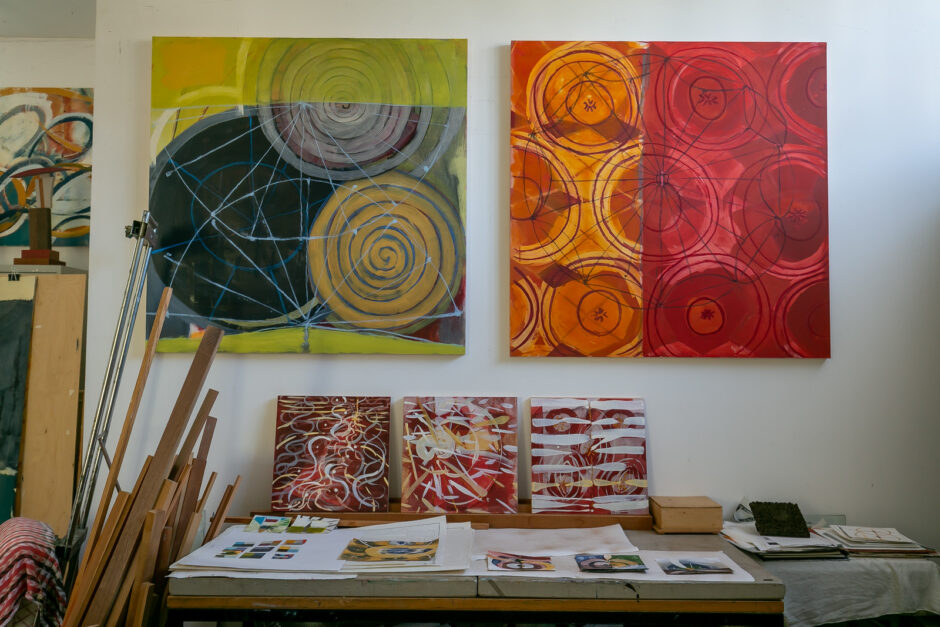

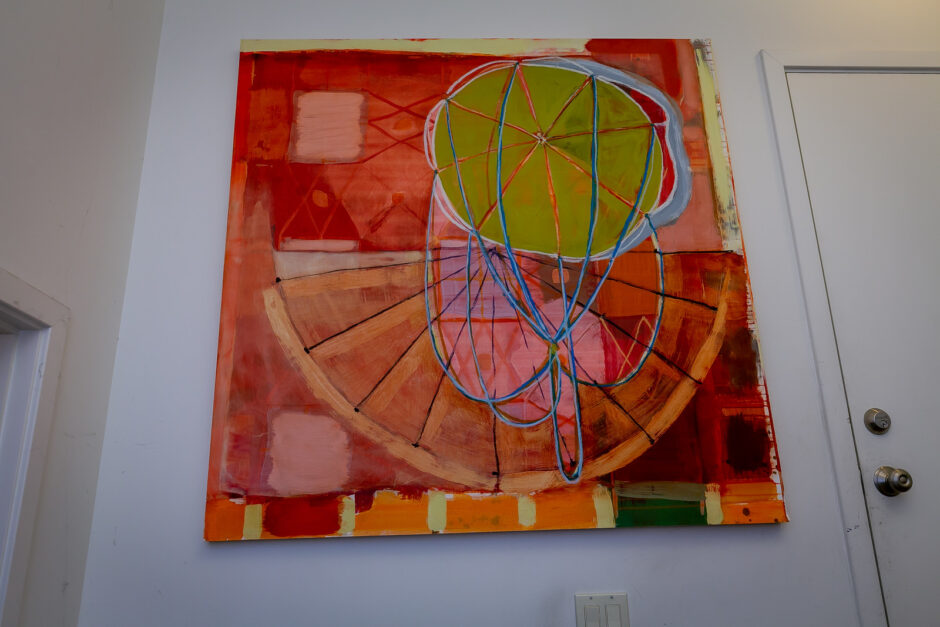


Check out the toy cars that I mentioned but didn’t show in my Joe Slusky post.
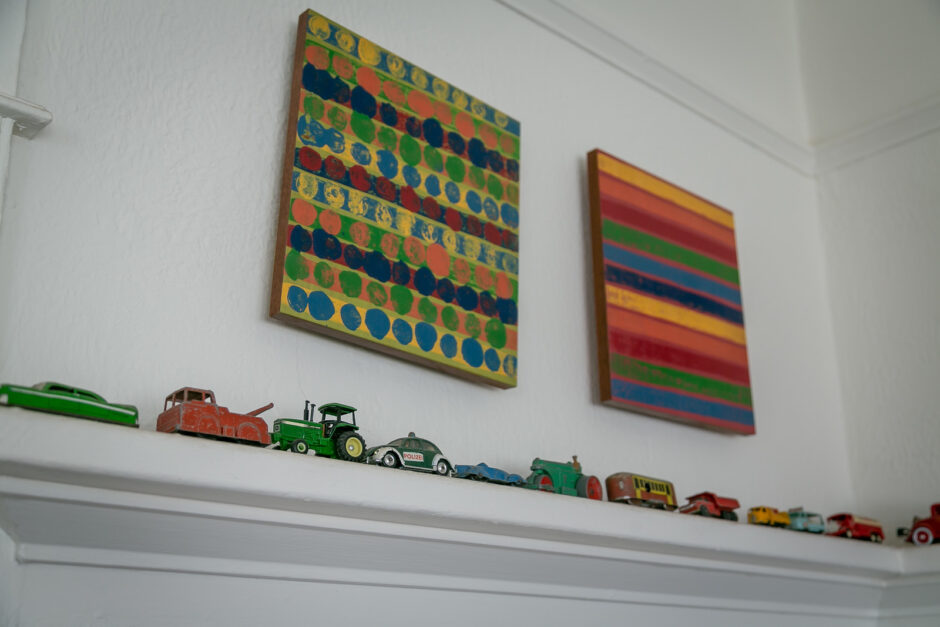










Note the wooden sculpture. Of working with wood, she writes: “During the few years that I was primarily painting with egg tempera on wood, I sourced the wood from a local furniture maker. Daily I would find beautiful pieces of mahogany, cherry and other exotic hardwoods in their dumpster. These were ends of boards too small for them to use but perfect for paintings. Additionally there were many interesting shaped pieces that I collected until I’d amassed an impressive collection. Eventually I started assembling these shapes into sculptures which I often painted as well.”
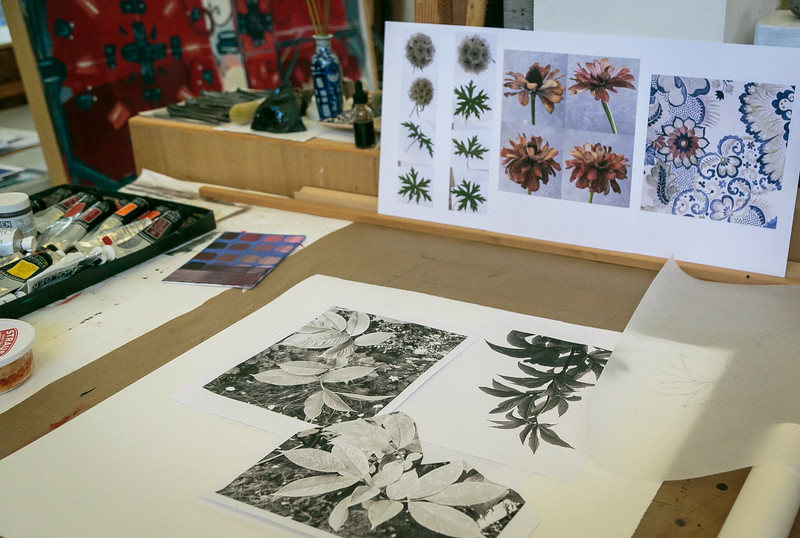




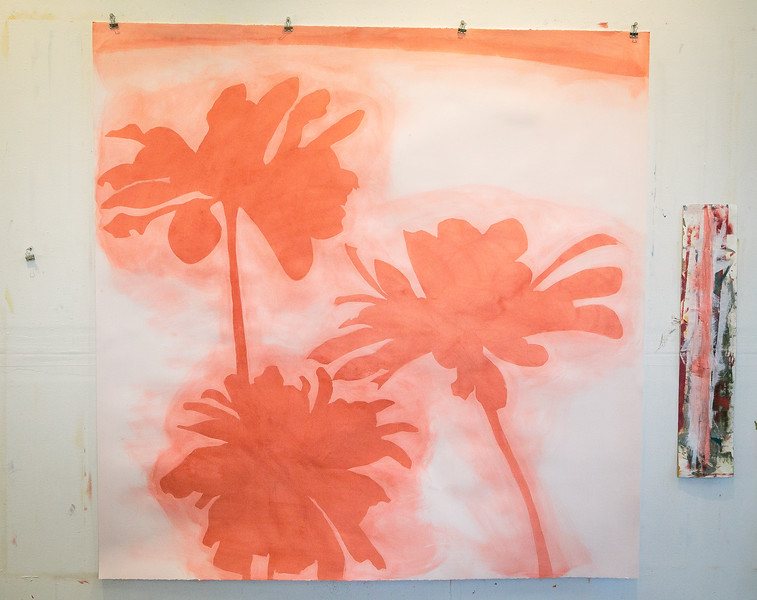
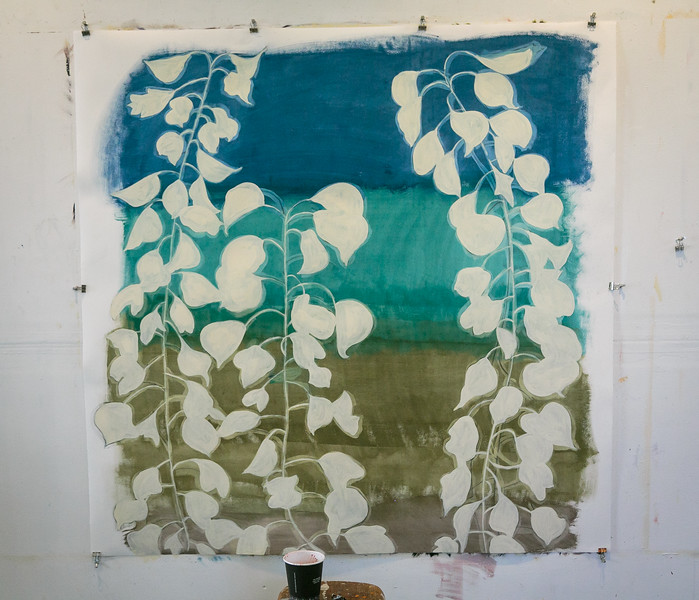



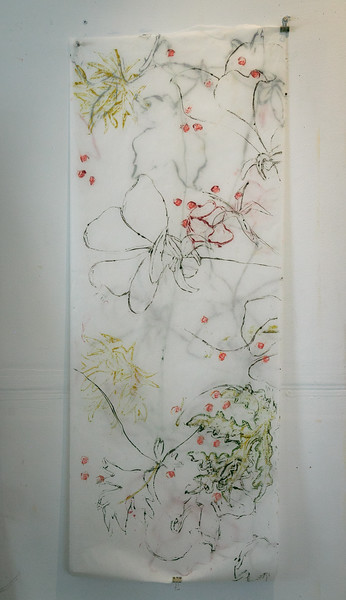

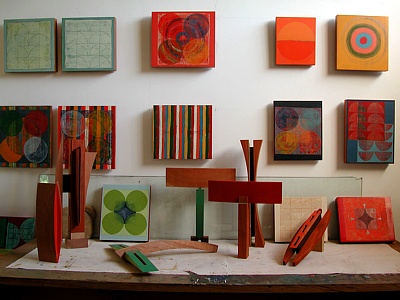
More wood.


In the Joe Slusky post, I showed you what he painted on the temporary plywood around the Builders Booksource. Here is what Katie painted, on the right:


Katie keeps an ever-changing altar where she works. She is very attuned to things – shapes, texture, color.







John Storey photographed not just her work, but also her tools and workplace. I find these next few photos very interesting, recognizing that some might not:



In 2006, Katie began transforming the back yard garden




One of the easiest annuals to grow, zinnias bring an explosion of color wherever they go. I don’t see a lot of them in Berkeley, perhaps because of our strong preference for perennials.
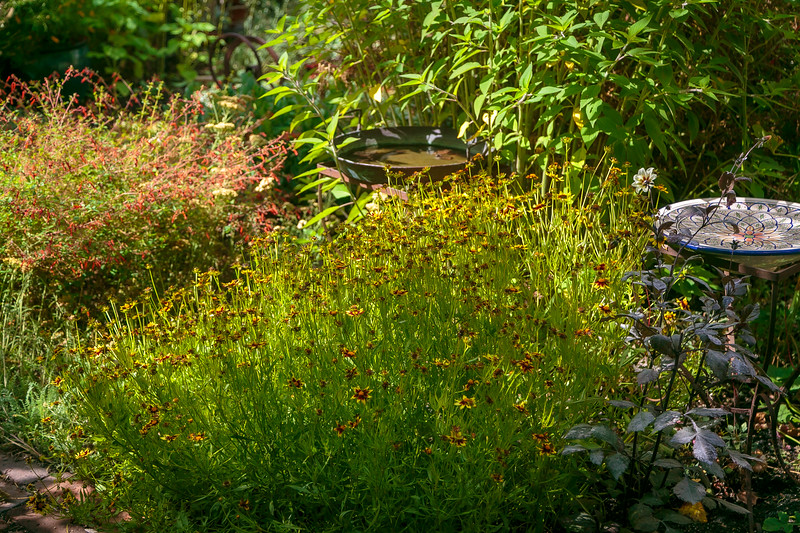








John Keats’ “Ode to a Nightingale” is a beacon for Hawkinson.
Away! away! for I will fly to thee,
Not charioted by Bacchus and his pards,
But on the viewless wings of Poesy,
Wow.
Hawkinson said one of the most profound and heart-warming things that I’ve heard in my Quirky Berkeley explorations: “I’m amazed that i get to do what i get to do”
My friend took the draft of this post to his quarters to read. When he came back to my kitchen, he tossed a photo on the counter.

“This my friend is , where your friend Hilary lives. When I was hanging out with Gabby in Philadelphia on the grape boycott in `1970, I went up to Reading with Steve Burrell for a couple days. I followed a produce broker from Reading down to Birdsboro. I persuaded him to dump the grapes and then invited him for piece of pie at the Sunset Diner. Steaks, chops, seafood, Open 24 hours a day. They claimed to have the Best in Dutch Cooking. They gave a free cake to all banquets and parties. That’s a deal. Good pie too. I had apple. Cold. Of course. With a glass of milk. When they say Dutch they mean German, of course. I once read much too much about their widespread devoicing of obstruents.

“The Sunset was okay. The next day I found Moore’s in Reading. That, my friend, was heaven. It made me FEEL this…” He handed me a typed version of one of his favorite Kerouac passages:
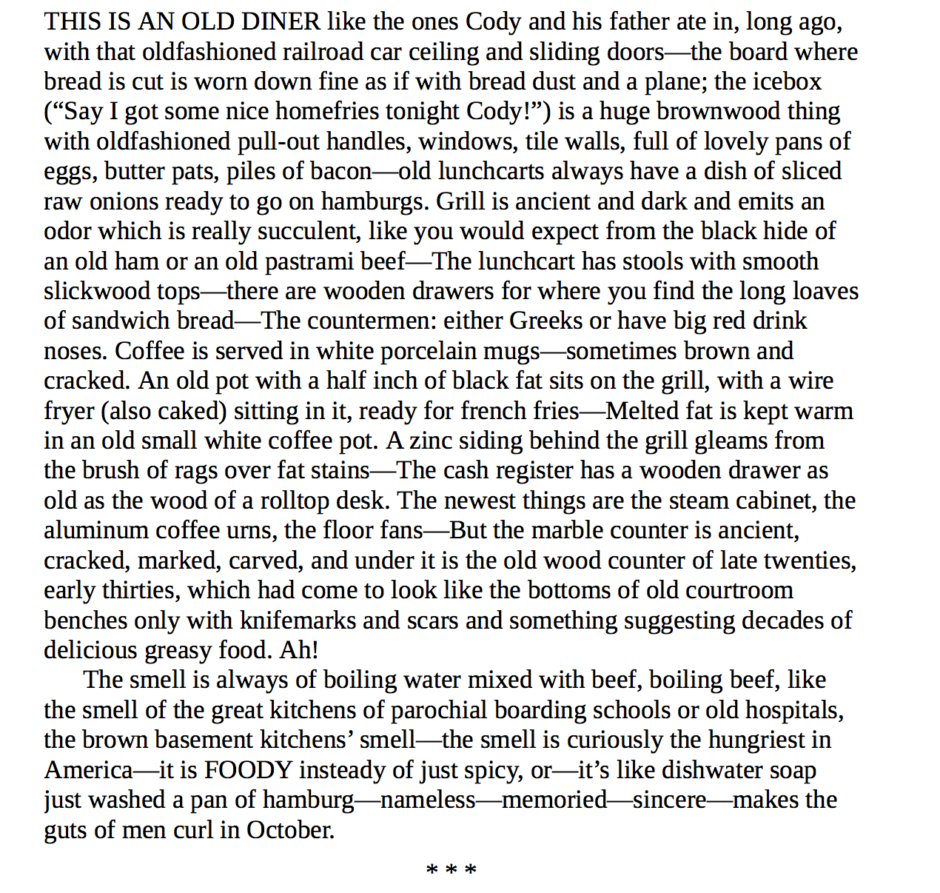
Diners rule for me.

I’ve blogged here about the Mari-Nay diner of my Pennsylvania youth.
I thanked him for the anecdotes and asked what he thought about my post on Katie Hawkinson. He pointed at the part where she said she can’t believe she gets to do what she she does. He smiled, and said



